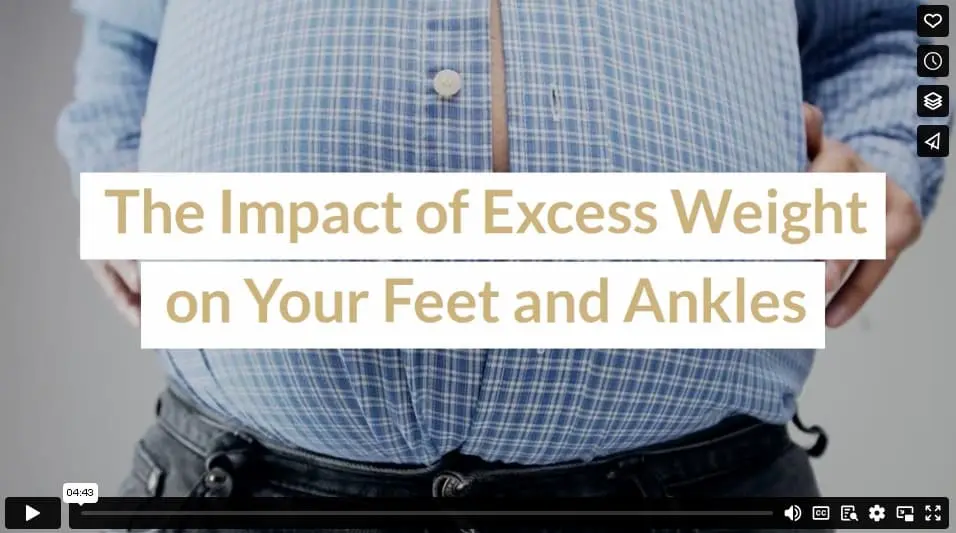Although obesity contributes to many serious health problems, including heart disease, type 2 diabetes, and high blood pressure, the impact of excessive weight on the lower body can also lead to foot and ankle pain. Too many extra pounds on a person’s frame can make standing or walking uncomfortable. Serious problems can develop if it is left untreated. Here is a short list of foot and ankle conditions brought on by obesity.
• Plantar Fasciitis
The plantar fascia is a fibrous ligament which runs the length of the sole, connecting the heel bone to the toe bones. It acts as a shock absorber and supports the arch of the foot. When this ligament becomes stressed by bearing too much weight, inflammation can develop. This condition is called plantar fasciitis, and it can be quite painful. The pain occurs on the bottom of the foot, the back of the heel, and in the arch, especially when standing or walking.
• Bunions
This is a common condition where the big toe moves inward toward the second toe, creating a bump on the outside of the big toe. This protrusion can rub when wearing any type of shoe causing significant discomfort. A quarter of obese people develop bunions.
• Hammertoe
This is another common foot deformity which can develop due to excess weight. A hammertoe occurs when one of the middle toes’ tendons and ligaments become stressed, causing the middle joint of the toe to bend in an odd direction. Over time, a hammertoe can become frozen in the distorted position, making walking difficult and sometimes painful.
• Flat feet
The arch of the foot helps balance the body and roll the foot forward to assist with walking. However, when the arches support too much weight for too long, the tendons and ligaments can wear out, causing the arch of the foot to flatten out. Collapsed arches, or what is known commonly as flat feet, makes standing and walking uncomfortable.
• Achilles Tendinitis
Similar to plantar fasciitis, tendinitis occurs with inflammation from carrying extra weight. This condition develops in the Achilles tendon, which connects the heel bone to the calf muscle. This often happens after developing flat feet. Achilles tendinitis can be very painful.
• Bone spurs
This condition occurs when two bones rub against each other and develop an extra growth where they meet in an attempt to reduce the friction. Although bone spurs can occur in any part of the body, they develop more often in the ankles and heels of overweight individuals, due to the added stress on the joints. The condition is characterized by pain, stiffness, numbness, and tingling.
• Arthritis
Ankle arthritis is a condition that occurs when cartilage wears out in the ankle joints. Cartilage is the connective tissue that cushions the bones where they fit together. Once cartilage has worn away, walking becomes quite painful. Obesity contributes to this condition and also to rheumatoid arthritis, which is more severe. Rheumatoid arthritis is an autoimmune disease where the body’s immune system attacks the cartilage of all the joints, not just in the ankles and feet.
• Gout
Gout is a condition brought on by the buildup of uric acid crystals in the joints of the feet, especially in the big toes. In healthy individuals, the kidneys remove uric acid from the body. However, in overweight individuals, the kidneys may struggle to do their job, allowing uric acid to build up in the body.
• Diabetic Foot Conditions
Obesity is the most common cause of developing type 2 diabetes. Diabetes compresses the nerves in the legs and feet and also reduces blood flow to the feet.
- Sores can develop from the reduced blood flow, and these are difficult to heal. Untreated sores can develop gangrene, resulting in the need for foot amputation. For this reason, diabetics should see a podiatrist for diabetics right away if experiencing pain or numbness in the feet.
- Numbness in the feet could indicate another serious condition called neuropathy. Symptoms for neuropathy also include pain, sensitivity to touch, loss of feeling in the feet, and loss of balance.
• Peripheral Artery Disease
This condition is created by fatty deposits in the arteries, which reduces blood flow to the brain, heart, legs, and feet. Symptoms include an unpleasant sensation of always having cold feet, sores that won’t heal, and numbness.
Foot and Ankle Conditions in Children
Foot problems associated with excess weight aren’t limited to adults. Overweight children are at increased risk of stress fractures and a condition called Sever’s disease. The symptom of Sever’s is excruciating heel pain, especially during growth spurts. Obese children risk developing flat feet, which can create pain in the calves and arches.
This short list is not comprehensive. Obesity contributes to many foot and ankle conditions, due to the added stress of supporting the body’s extra weight. It’s recommended that a person suffering from any type of ankle or foot pain sees a podiatrist right away. With proper treatment, many of the conditions listed could be reduced or alleviated, but losing even a small amount of weight could prevent them altogether.
Video
Infographic
Obesity can cause serious health issues, including foot and ankle pain, as extra weight often makes standing or walking uncomfortable. Discover in this infographic some foot and ankle conditions linked to obesity.





